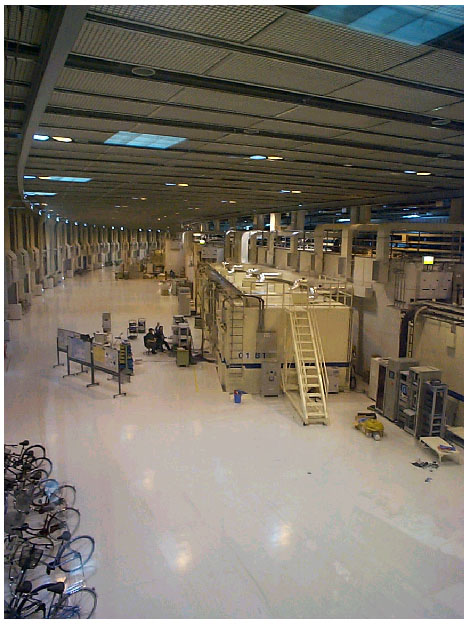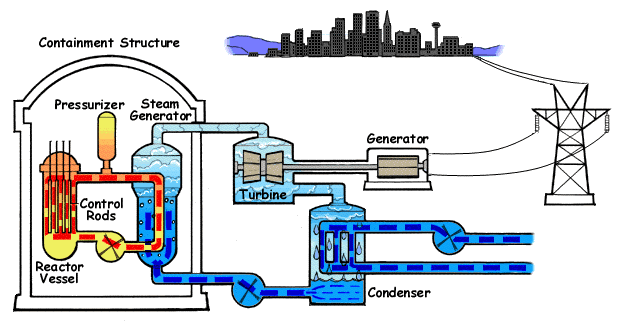|
Induced Gamma Emission
In physics, induced gamma emission (IGE) refers to the process of fluorescent emission of gamma rays from excited nuclei, usually involving a specific nuclear isomer. It is analogous to conventional fluorescence, which is defined as the emission of a photon (unit of light) by an excited electron in an atom or molecule. In the case of IGE, nuclear isomers can store significant amounts of excitation energy for times long enough for them to serve as nuclear fluorescent materials. There are over 800 known nuclear isomers but almost all are too intrinsically radioactive to be considered for applications. there were two proposed nuclear isomers that appeared to be physically capable of IGE fluorescence in safe arrangements: tantalum-180m and hafnium-178m2. History Induced gamma emission is an example of interdisciplinary research bordering on both nuclear physics and quantum electronics. Viewed as a nuclear reaction it would belong to a class in which only photons were involved in creat ... [...More Info...] [...Related Items...] OR: [Wikipedia] [Google] [Baidu] |
Physics
Physics is the scientific study of matter, its Elementary particle, fundamental constituents, its motion and behavior through space and time, and the related entities of energy and force. "Physical science is that department of knowledge which relates to the order of nature, or, in other words, to the regular succession of events." It is one of the most fundamental scientific disciplines. "Physics is one of the most fundamental of the sciences. Scientists of all disciplines use the ideas of physics, including chemists who study the structure of molecules, paleontologists who try to reconstruct how dinosaurs walked, and climatologists who study how human activities affect the atmosphere and oceans. Physics is also the foundation of all engineering and technology. No engineer could design a flat-screen TV, an interplanetary spacecraft, or even a better mousetrap without first understanding the basic laws of physics. (...) You will come to see physics as a towering achievement of ... [...More Info...] [...Related Items...] OR: [Wikipedia] [Google] [Baidu] |
Laser
A laser is a device that emits light through a process of optical amplification based on the stimulated emission of electromagnetic radiation. The word ''laser'' originated as an acronym for light amplification by stimulated emission of radiation. The first laser was built in 1960 by Theodore Maiman at Hughes Research Laboratories, based on theoretical work by Charles H. Townes and Arthur Leonard Schawlow and the optical amplifier patented by Gordon Gould. A laser differs from other sources of light in that it emits light that is coherence (physics), ''coherent''. Spatial coherence allows a laser to be focused to a tight spot, enabling uses such as optical communication, laser cutting, and Photolithography#Light sources, lithography. It also allows a laser beam to stay narrow over great distances (collimated light, collimation), used in laser pointers, lidar, and free-space optical communication. Lasers can also have high temporal coherence, which permits them to emit light ... [...More Info...] [...Related Items...] OR: [Wikipedia] [Google] [Baidu] |
Particle-induced Gamma Emission
Particle-induced gamma-ray emission (PIGE) spectroscopy is a form of nuclear reaction analysis, one of the ion beam analysis thin-film analytical techniques. Technology Typically, an MeV proton beam is directed onto a sample which may be tens of microns thick, and the fast protons may excite the target nuclei such that gamma rays are emitted. These may be used to characterise the sample. For example, sodium in glass is of great importance but can be hard to measure non destructively: X-ray fluorescence (XRF) and particle-induced X-ray emission (PIXE) are both sensitive only to the surface few microns of the sample because of the low energy (and consequent high absorption coefficient) of the Na K X-rays (1.05 keV). But, for example, the 23Na(p,p'γ)23Na reaction has a high and relatively well-known cross-section (see the IAEA "IBANDL" site) and is therefore frequently used for determining bulk sodium content of glasses, since the gamma energy (440 keV) is so high that there is ... [...More Info...] [...Related Items...] OR: [Wikipedia] [Google] [Baidu] |
Nuclear Proliferation
Nuclear proliferation is the spread of nuclear weapons to additional countries, particularly those not recognized as List of states with nuclear weapons, nuclear-weapon states by the Treaty on the Non-Proliferation of Nuclear Weapons, commonly known as the ''Non-Proliferation Treaty'' or ''NPT''. Nuclear proliferation occurs through the spread of fissile material, and the technology and capabilities needed to produce it and to Nuclear weapon design, design and manufacture nuclear weapons. In a modern context, it also includes the spread of nuclear weapons to non-state actors. Proliferation has been opposed by many nations with and without nuclear weapons, as governments fear that more countries with nuclear weapons will increase the possibility of nuclear warfare (including the so-called countervalue targeting of civilians), de-stabilize international relations, or infringe upon the principle of Sovereign state, state sovereignty. Conversely, supporters of deterrence theory arg ... [...More Info...] [...Related Items...] OR: [Wikipedia] [Google] [Baidu] |
Pure Fusion Weapon
A pure fusion weapon is a hypothetical hydrogen bomb design that does not need a fission "primary" explosive to ignite the fusion of deuterium and tritium, two heavy isotopes of hydrogen used in fission-fusion thermonuclear weapons. Such a weapon would require no fissile material and would therefore be much easier to develop in secret than existing weapons. Separating weapons-grade uranium (U-235) or breeding plutonium (Pu-239) requires a substantial and difficult-to-conceal industrial investment, and blocking the sale and transfer of the needed machinery has been the primary mechanism to control nuclear proliferation to date. Explanation All current thermonuclear weapons use a fission bomb as a first stage to create the high temperatures and pressures necessary to start a fusion reaction between deuterium and tritium in a second stage. For many years, nuclear weapon designers have researched whether it is possible to create high enough temperatures and pressures inside a conf ... [...More Info...] [...Related Items...] OR: [Wikipedia] [Google] [Baidu] |
Fusion Bomb
A nuclear weapon is an explosive device that derives its destructive force from nuclear reactions, either fission (fission or atomic bomb) or a combination of fission and fusion reactions (thermonuclear weapon), producing a nuclear explosion. Both bomb types release large quantities of energy from relatively small amounts of matter. Nuclear bombs have had yields between 10 tons (the W54) and 50 megatons for the Tsar Bomba (see TNT equivalent). Yields in the low kilotons can devastate cities. A thermonuclear weapon weighing as little as can release energy equal to more than 1.2 megatons of TNT (5.0 PJ). Apart from the blast, effects of nuclear weapons include firestorms, extreme heat and ionizing radiation, radioactive nuclear fallout, an electromagnetic pulse, and a radar blackout. The first nuclear weapons were developed by the Allied Manhattan Project during World War II. Their production continues to require a large scientific and industrial complex, primarily f ... [...More Info...] [...Related Items...] OR: [Wikipedia] [Google] [Baidu] |
Nuclear Fusion
Nuclear fusion is a nuclear reaction, reaction in which two or more atomic nuclei combine to form a larger nuclei, nuclei/neutrons, neutron by-products. The difference in mass between the reactants and products is manifested as either the release or absorption (electromagnetic radiation), absorption of energy. This difference in mass arises as a result of the difference in nuclear binding energy between the atomic nuclei before and after the fusion reaction. Nuclear fusion is the process that powers all active stars, via many Stellar nucleosynthesis, reaction pathways. Fusion processes require an extremely large Lawson criterion, triple product of temperature, density, and confinement time. These conditions occur only in Stellar core, stellar cores, advanced Nuclear weapon design, nuclear weapons, and are approached in List of fusion experiments, fusion power experiments. A nuclear fusion process that produces atomic nuclei lighter than nickel-62 is generally exothermic, due t ... [...More Info...] [...Related Items...] OR: [Wikipedia] [Google] [Baidu] |
Radiological Weapon
In physics, radiation is the emission or transmission of energy in the form of waves or particles through space or a material medium. This includes: * ''electromagnetic radiation'' consisting of photons, such as radio waves, microwaves, infrared, visible light, ultraviolet, x-rays, and gamma radiation (γ) * ''particle radiation'' consisting of particles of non-zero rest energy, such as alpha radiation (α), beta radiation (β), proton radiation and neutron radiation * '' acoustic radiation'', such as ultrasound, sound, and seismic waves, all dependent on a physical transmission medium * ''gravitational radiation'', in the form of gravitational waves, ripples in spacetime Radiation is often categorized as either '' ionizing'' or '' non-ionizing'' depending on the energy of the radiated particles. Ionizing radiation carries more than 10 electron volts (eV), which is enough to ionize atoms and molecules and break chemical bonds. This is an important distinction due to the lar ... [...More Info...] [...Related Items...] OR: [Wikipedia] [Google] [Baidu] |
Hafnium Controversy
The hafnium controversy was a debate over the possibility of "triggering" rapid energy releases, via gamma-ray emission, from 178m2Hf, a nuclear isomer of hafnium. The energy release per event is 5 orders of magnitude (100,000 times) higher than in a typical chemical reaction, but 2 orders of magnitude less than a nuclear fission reaction. In 1998, a group led by Carl Collins in the University of Texas at Dallas reported having successfully initiated such a trigger. Signal-to-noise ratios were small in those first experiments, and to date no other group has been able to reproduce these results. Peter Zimmerman (an American nuclear physicist and arms-control expert) described claims of weaponization potential as having been based on " very bad science". Background 178m2Hf is a particularly interesting candidate for induced gamma emission (IGE) experiments, because 178m2Hf's energy is 2.5 MeV per nucleus higher than that of ground-state Hf, and it has a long 31-year ... [...More Info...] [...Related Items...] OR: [Wikipedia] [Google] [Baidu] |
Nuclear Propulsion
Nuclear propulsion includes a wide variety of propulsion methods that use some form of nuclear reaction as their primary power source. Many aircraft carriers and submarines currently use uranium fueled nuclear reactors that can provide propulsion for long periods without refueling. There are also applications in the space sector with nuclear thermal and nuclear electric engines which could be more efficient than conventional rocket engines. The idea of using nuclear material for propulsion dates back to the beginning of the 20th century. In 1903 it was hypothesized that radioactive material, radium, might be a suitable fuel for engines to propel cars, planes, and boats. H. G. Wells picked up this idea in his 1914 fiction work '' The World Set Free''. Surface ships, submarines, and torpedoes Nuclear-powered vessels are mainly military submarines, and aircraft carriers. Russia is the only country that currently has nuclear-powered civilian surface ships, mainly icebreaker ... [...More Info...] [...Related Items...] OR: [Wikipedia] [Google] [Baidu] |
Radiation Therapy
Radiation therapy or radiotherapy (RT, RTx, or XRT) is a therapy, treatment using ionizing radiation, generally provided as part of treatment of cancer, cancer therapy to either kill or control the growth of malignancy, malignant cell (biology), cells. It is normally delivered by a linear particle accelerator. Radiation therapy may be cure, curative in a number of types of cancer if they are localized to one area of the body, and have not metastasis, spread to other parts. It may also be used as part of adjuvant therapy, to prevent tumor recurrence after surgery to remove a primary malignant tumor (for example, early stages of breast cancer). Radiation therapy is synergistic with chemotherapy, and has been used before, during, and after chemotherapy in susceptible cancers. The subspecialty of oncology concerned with radiotherapy is called radiation oncology. A physician who practices in this subspecialty is a radiation oncologist. Radiation therapy is commonly applied to the canc ... [...More Info...] [...Related Items...] OR: [Wikipedia] [Google] [Baidu] |








